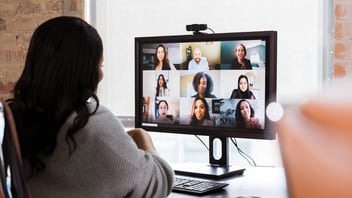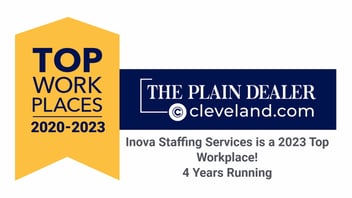How to Shut Down Workplace Incivility
The following is a guest post from Carole Wehn (CultureWise). Carole works behind the scenes at HPC, writing, editing, and proofreading online learning materials.
Transitioning from Quiet Quitting to Remarkable Success
By Carole Wehn
A small handwritten sign by the doctor’s office check-out window said it all. "It doesn't cost extra to be nice."
During the pandemic, reports of customers treating healthcare workers poorly were rampant. People took their fears and frustrations out on the frontline workers trying to help them. Since then, reports of incivility in the workplace have continued to rise. Incivility takes many forms, and it comes from customers, peers, and company leaders.
Forbes contributor Audrey Murrell defined incivility as "a form of psychological harassment and emotional aggression that violates the social norm of mutual respect." In short, it is rudeness and a lack of respect that doesn't escalate to the level of violence. It affects workers' mental health, their job performance, and employee satisfaction. It even impacts those who witness incivility. Ensure your company culture is one of zero tolerance for such behaviors.
Why Are People So Angry?
A 2022 survey of global frontline workers by Christine Porath found that:
- 76 percent experience incivility at least once a month
- 73 percent said it is not unusual for customers to behave badly
- 78 percent believe that bad behavior from customers toward employees is more common than it was five years ago.
A decade prior, she found that 61 percent of workers reported it was not unusual for customers to misbehave. Only half of respondents thought bad customer behavior increased over the prior five years.
Porath believes the primary driver of incivility is stress. Almost three-quarters of her survey respondents blamed it for their bad behavior. Not coincidentally, Gallup's 2023 State of the Workplace Report also found stress to be on the rise over the last decade. Contributing factors include the continued impact of the pandemic, political divisiveness, and the changing nature of work.
A weakening sense of community adds to the growing incivility. The pandemic spiked a sense of, "we're all in this together," but it quickly abated. Remote work locations and Zoom meetings make it challenging for co-workers to bond. Employees feel isolated and may feel disrespected by their managers. The heightened use of technology ties people to their devices to the point where they are unaware of people right in front of them. The tone and intent of digital messages are easily misinterpreted. The proliferation of negative content online makes users feel more anxious, angry, and depressed.
One of Porath's biggest takeaways is that incivility is usually not intentional. It is a symptom of people's lack of self-awareness. Research reported in the Harvard Business Review indicates that 95 percent of people believe they are self-aware. Yet only about 10-15 percent are. The rest have good intentions but don't realize how they come across to others. Since incivility is in the eyes of the recipient, the other party may not think they are ignoring someone or being disrespectful.
Incivility's Impact on the Workplace
Regardless of the intent, incivility negatively affects employee engagement and business results. Being the target of incivility sends us into "flight or fight" mode. Our focus on what happened interrupts our focus on our work. A study found that mistreated people had difficulty paying attention to detail. They struggled to perform simple calculations.
Brad Smith, PhD., Chief Science Officer of meQuilibrium, described the results of a March 2023 survey on worker well-being.
"When employees are subjected to rude, disrespectful, or aggressive behavior in the workplace, it can lead to decreased job satisfaction, increased stress and decreased productivity, which can result in higher rates of absenteeism, turnover, and decreased organizational performance," he observed.
Smith notes that incivility can be something as seemingly minor as being ignored, having one’s judgment questioned, or being spoken to in an unprofessional manner. His firm found that managers who are attentive to team well-being can reduce turnover risk by as much as 78 percent.
Incivility kills collaboration. Employees who think they have been disrespected are much less likely to share information and help others. In healthcare, exposure to rudeness harms medical diagnoses and procedure outcomes. Conversely, when employees feel respected and safe, their individual as well as team performance improves.
When employees believe they have been mistreated, they reduce their time and effort at work. Almost always, their engagement and commitment to the organization decline.
Employees often respond by leaving the company. When they do, they frequently don't tell management about the behaviors they experienced.
Likewise, customers encountering toxic employees often take their business elsewhere without explaining why. Even one unfortunate encounter may cause customers to make assumptions about the company and the brand.
Is the Customer Always Right?
Psychology professor Alicia Grandey reported in the Harvard Business Review that employees are twice as likely to experience incivility from customers than from their co-workers. She notes that customers have no sense of accountability or negative repercussions. Many customers abide by the saying, "The customer is always right," so they feel they can say and do whatever they please.
The employee may then feel trapped by the need to provide "service with a smile." They might depend on receiving a good tip. They may fear the customer will complain to their management and they will lose their job.
CultureWise CEO and author David J. Friedman wrote in Culture by Design,
"Have you ever had a customer who was consistently abusive to your staff? Think of that customer with whom no one wants to work. The one who sees the world from a "win-lose" perspective. The one who operates from an entirely different set of behavioral standards than that which you're trying to teach. When you continue to do business with these customers, you're telling your team that the revenue generated by the customer is more important than your culture."
Some organizations have stepped up their defense of workers mistreated by customers. One example is the zero-tolerance policy adopted by the FAA to address unruly passenger behavior on airlines. Some companies allow employees to escalate customer service interactions or hang up on difficult callers. Others have chosen to "fire" troublesome customers after unsuccessfully trying to build a mutually beneficial relationship.
Misuse of Power
Workplace incivility includes leaders misusing their power over subordinates. A microaggression such as ignoring a worker's comment can make an employee worry about their job and disengage. Leaders are the ones who set the tone for an organization, so they must set a positive example. Uncivil workers called out for incivility often say their workplace culture tolerated or even encouraged such behavior.
Leadership must establish a zero-tolerance policy for incivility. This policy must apply to everyone, from frontline workers to top executives.
The Leaders' Role
Unlike harassment, there is no bright line demarcating civility. Leaders need to create a positive, supportive culture. Inspiring trust, showing meaningful appreciation for employee efforts, and conveying respect are required behaviors. As noted in a Psychology Today article, "Simply telling people to act respectfully towards others is not going to have the same positive effect as it would by exhibiting that behavior yourself."
If policies and a process for reporting incivility are implemented, they must be enforced. Reporting violations must be easily accomplished. Employees need to feel encouraged to do so and see that the issues they raise are taken seriously. Staff members may fear reprisal and may be uncomfortable speaking up. They need to know that management will listen to their concerns and will support them.
Managers must support frontline workers when witnessing incivility. It's helpful for them to step in and mediate the situation. If that is not possible, they need to provide their team with the tools to defuse a situation and the authority to ask customers to leave the premises. The employee needs to understand that their supervisor has their back. After the encounter, the manager should check in on the employee and encourage discussion about what happened.
>>> Related Resource: A Good Manager Will Be These Four Things
Shutting Down Incivility
An organization whose culture promotes empathy helps prevent uncivil behavior. Empathetic people understand the importance of generous listening, putting oneself in another's shoes, and working through differences. These skills help in managing difficult conversations and defusing incivility.
Companies can screen potential employees for their ability to handle incivility on the job. "Tell me about an experience where you had to deal with a difficult customer or situation at work" is a helpful interview question. Candidates who are self-aware and open to learning are also likely to deal well with incivility.
Training on giving and receiving feedback, working across cultural differences, and dealing with difficult people are additional ways to equip employees with the skills they need to de-escalate situations.
The most important thing leaders can do, however, is to treat their employees with respect. Christine Porath noted from her research, "Being treated with respect was more important than recognition and appreciation, communicating or inspiring vision, providing useful feedback, or even providing opportunities for learning, growth, and development." Show your people what respect looks like, and they will show it to others.
>>> Related Resource: Fostering a Culture Where Employees Feel Like They Belong
Inova Staffing Insights
Dan Barnett, President & CEO of Inova Staffing, says:

It's alarming to learn that workplace incivility is on the rise. It's clear that fostering a culture of respect and zero tolerance for incivility is paramount to maintaining a positive work environment and maximizing organizational performance. As leaders, we must prioritize addressing workplace incivility head-on, recognizing its detrimental effects on employee engagement and productivity. By implementing proactive measures to promote respectful interactions and providing support for employees facing incivility, we can cultivate a work culture where everyone feels valued and empowered to thrive.
Interested in More Employment Resources?
Whether looking for a job or seeking new candidates, the Better Together Blog is packed with advice and insights to help you succeed. Subscribe below to receive the latest content in your inbox—directly from staffing industry experts.

Enter your email address to receive updates when we publish new content.




